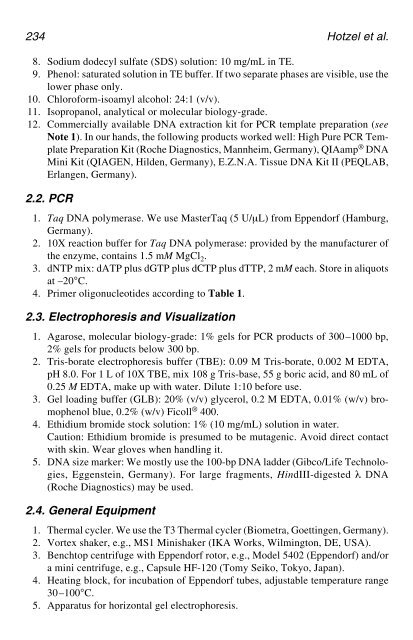PCR Detection of Microbial Pathogens PCR Detection of Microbial ...
PCR Detection of Microbial Pathogens PCR Detection of Microbial ...
PCR Detection of Microbial Pathogens PCR Detection of Microbial ...
You also want an ePaper? Increase the reach of your titles
YUMPU automatically turns print PDFs into web optimized ePapers that Google loves.
234 Hotzel et al.<br />
8. Sodium dodecyl sulfate (SDS) solution: 10 mg/mL in TE.<br />
9. Phenol: saturated solution in TE buffer. If two separate phases are visible, use the<br />
lower phase only.<br />
10. Chlor<strong>of</strong>orm-isoamyl alcohol: 24:1 (v/v).<br />
11. Isopropanol, analytical or molecular biology-grade.<br />
12. Commercially available DNA extraction kit for <strong>PCR</strong> template preparation (see<br />
Note 1). In our hands, the following products worked well: High Pure <strong>PCR</strong> Template<br />
Preparation Kit (Roche Diagnostics, Mannheim, Germany), QIAamp ® DNA<br />
Mini Kit (QIAGEN, Hilden, Germany), E.Z.N.A. Tissue DNA Kit II (PEQLAB,<br />
Erlangen, Germany).<br />
2.2. <strong>PCR</strong><br />
1. Taq DNA polymerase. We use MasterTaq (5 U/µL) from Eppendorf (Hamburg,<br />
Germany).<br />
2. 10X reaction buffer for Taq DNA polymerase: provided by the manufacturer <strong>of</strong><br />
the enzyme, contains 1.5 mM MgCl 2.<br />
3. dNTP mix: dATP plus dGTP plus dCTP plus dTTP, 2 mM each. Store in aliquots<br />
at –20°C.<br />
4. Primer oligonucleotides according to Table 1.<br />
2.3. Electrophoresis and Visualization<br />
1. Agarose, molecular biology-grade: 1% gels for <strong>PCR</strong> products <strong>of</strong> 300–1000 bp,<br />
2% gels for products below 300 bp.<br />
2. Tris-borate electrophoresis buffer (TBE): 0.09 M Tris-borate, 0.002 M EDTA,<br />
pH 8.0. For 1 L <strong>of</strong> 10X TBE, mix 108 g Tris-base, 55 g boric acid, and 80 mL <strong>of</strong><br />
0.25 M EDTA, make up with water. Dilute 1:10 before use.<br />
3. Gel loading buffer (GLB): 20% (v/v) glycerol, 0.2 M EDTA, 0.01% (w/v) bromophenol<br />
blue, 0.2% (w/v) Ficoll ® 400.<br />
4. Ethidium bromide stock solution: 1% (10 mg/mL) solution in water.<br />
Caution: Ethidium bromide is presumed to be mutagenic. Avoid direct contact<br />
with skin. Wear gloves when handling it.<br />
5. DNA size marker: We mostly use the 100-bp DNA ladder (Gibco/Life Technologies,<br />
Eggenstein, Germany). For large fragments, HindIII-digested λ DNA<br />
(Roche Diagnostics) may be used.<br />
2.4. General Equipment<br />
1. Thermal cycler. We use the T3 Thermal cycler (Biometra, Goettingen, Germany).<br />
2. Vortex shaker, e.g., MS1 Minishaker (IKA Works, Wilmington, DE, USA).<br />
3. Benchtop centrifuge with Eppendorf rotor, e.g., Model 5402 (Eppendorf) and/or<br />
a mini centrifuge, e.g., Capsule HF-120 (Tomy Seiko, Tokyo, Japan).<br />
4. Heating block, for incubation <strong>of</strong> Eppendorf tubes, adjustable temperature range<br />
30–100°C.<br />
5. Apparatus for horizontal gel electrophoresis.






